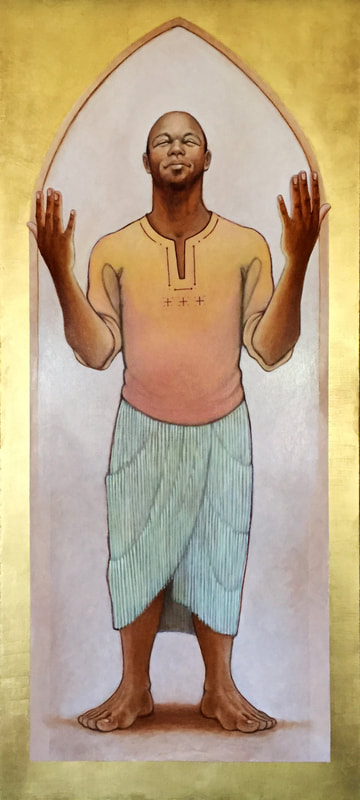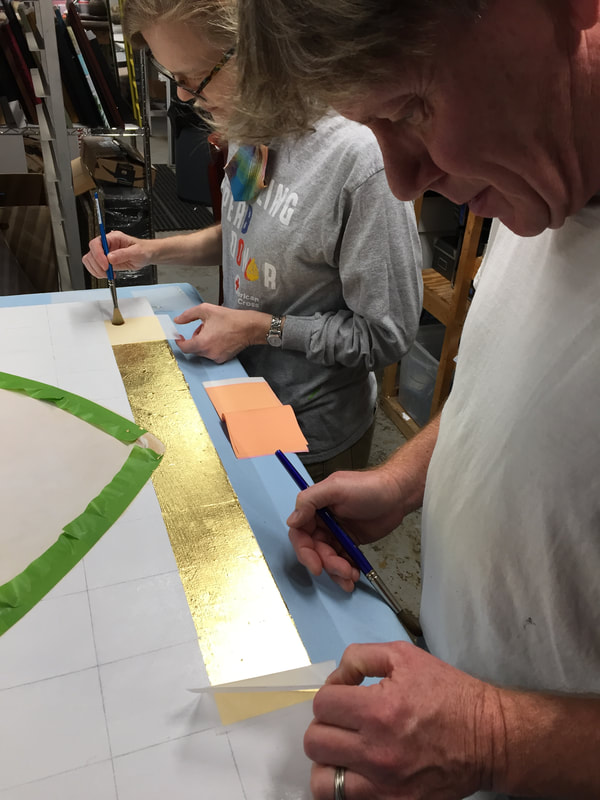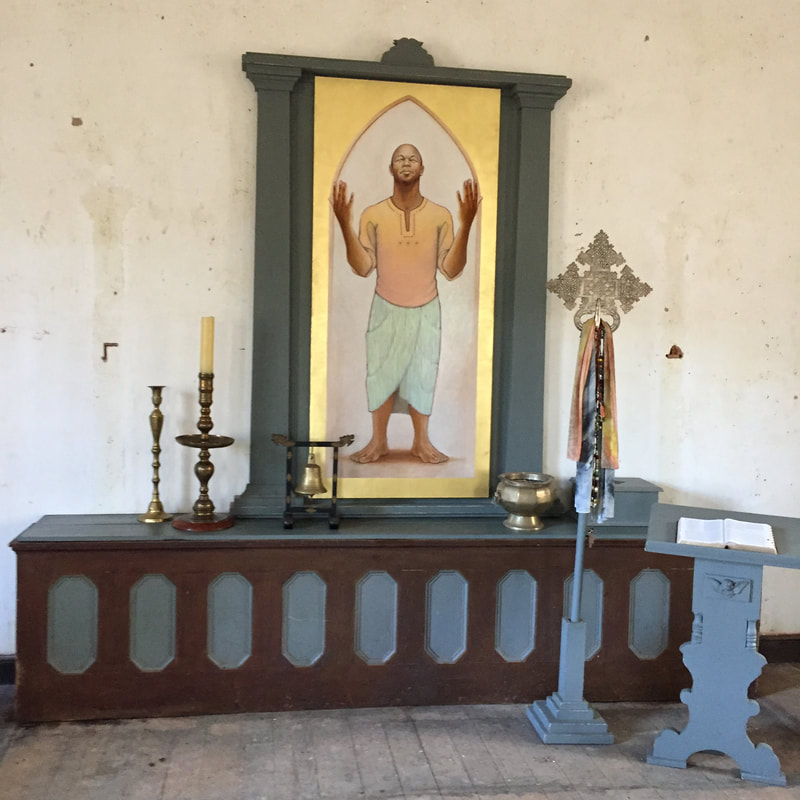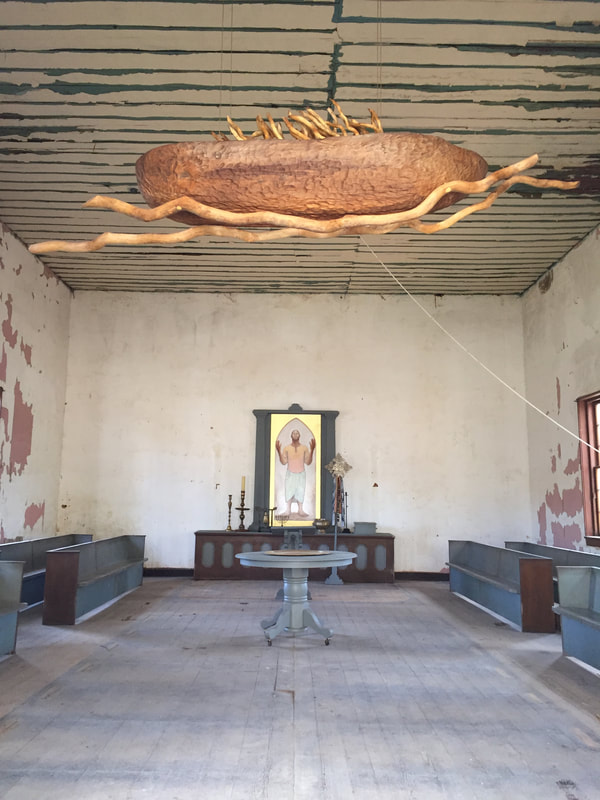oil on panel/gold leaf/reclaimed objects
As the Portiuncula Guild launches this new venture, we wanted an image of the apostle Thomas for the chapel’s new altarpiece. We laid out four criteria for the image: 1) it should invite visitors to prayer, 2) it should model how art would be utilized at the chapel and meditation garden, 3) it should honor the 175-year history of the place, and 4) it should reflect the open and inclusive values of the Guild.
Bedford native Lynne Goodwin stepped forward to offer both her skill and her theological insights and enthusiastically embraced all our goals for the new image. Lynne articulated these values brilliantly; “I see the apostle Thomas as a symbol of the promise that reconciliation is possible. We are like him, we have heard the words of others as they talk of an encounter with the divine - and we doubt, we long for our own experience. Like Thomas we need proof.”
To compliment Lynne’s vision of the apostle, Mitchell and I created the altarpiece’s framework from architectural elements that were handcrafted for the chapel’s interior by local artisans nearly two centuries ago. We loved the idea that we were not only honoring the past, but that we were adding our skills to theirs … a continuation of the work and prayer of an earlier time.
The image Lynne chose for the chapel altarpiece was not the “doubting apostle” that is so often remembered in the Christian imagination. Rather, she chose to focus on an ancient legend that claims that Thomas shared the gospel in India for decades after the resurrection. For Lynne, the most important message in the image is Thomas’ gesture of prayer. “I wanted to draw the viewer into Thomas’ courageous spirituality, his confession, and maybe most importantly, his profound example of prayer and praise.” This is an image of a spiritual seeker who no longer doubts. A new kind of guru in the lands of Hinduism and Buddhism.
Lynne describes her process for new painting of the apostle; “I started with the question of what a first-century Palestinian man who journeyed to India might have looked like. This painting needed to depict the body of a man who worked all his life with his hands but was also a deeply spiritual seeker. The image needed to be a man who would literally walk joyfully to the ends of the earth to share the good news he had received.”
Lynne said that it was important for her to depict the apostle honestly; but she incorporated symbolic elements into his clothing. “I wanted to imagine what a first century traveler would have worn, so I chose garments that were both traditional and basic to a poor Indian mystic.” Saffron is a sacred color for Hindus. The color represents fire, and as impurities are burnt-out by fire, the color came to symbolizes purity as well. Wearing the color as a spiritual seeker in India symbolizes the quest for enlightenment. Lynne suggests that “the blue green of the simple wrapped skirt of a servant is symbolic of the water that enfolds us in baptism, or the living water that quenches our thirst for belonging.”
“I see the apostle Thomas as a symbol of the promise that reconciliation is possible. We are like him, we have heard the words of others as they talk of an encounter with the divine - and we doubt, we long for our own experience. Like Thomas we need proof.”
The original chapel was most probably constructed in part by the forced labor of the enslaved people owned by some of the chapel’s original trustees. These enslaved craftsmen worked alongside the free craftsmen of the area to construct a holy place of prayer. Certainly, this experience was also a clash of cultures and cosmologies, since both black and white builders had differing understandings of god, prayer, the universe, and even what a house of god looked like. But maybe, just maybe, even amid the injustices and horrors of slavery from which the building of Thomas Chapel emerged, both black and white craftsmen recognized a beauty and dignity in the work they were doing together. And, of course, we like to think that the enslaved builders of Thomas Chapel wove some of their own native spirituality into its bricks and mortar as a kind of blessing and protective shield for this place. Lynne’s image of the apostle Thomas honors this possibility.
-VPE
Giving the medieval idea of an artist guild a modern twist, members of the Portiuncula Guild seeks to not only support one another in life, faith, work, and mission, guild members also promote each other’s vision to a wider world for the use, and benefit of, and in service to the entire community. Core activities of the guild are providing opportunities for retreat, meditation, and prayer, and occasional festival gatherings for creative seekers of all denominations and all faiths, offering hospitality and providing occasions for dialogue and conversation for all seeking a deeper spiritual, religious, imaginative experience within community. In addition, guild members are committed to exploring and experimenting with the creation and celebration of innovative and inclusive opportunities for gathering, contemplation, prayer, life cycle rituals, meaningful learning, community building and social change.
The Portiuncula Guild at Thomas Chapel will be a new way to explore being a faith community. The chapel will be a place for creative folks and spiritual seekers to explore new ways that the sacred and the imagination came together.





 RSS Feed
RSS Feed